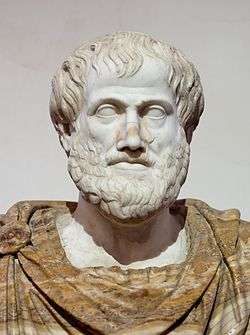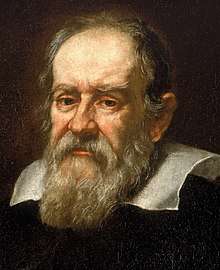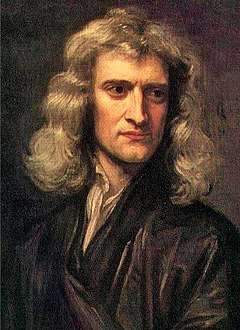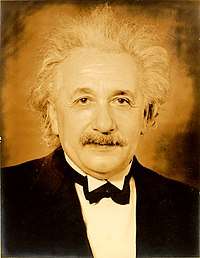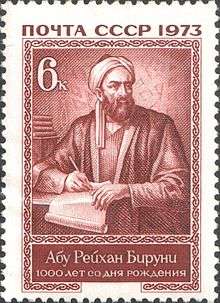History of gravitational theory
In physics, theories of gravitation postulate mechanisms of interaction governing the movements of bodies with mass. There have been numerous theories of gravitation since ancient times. The first extant sources discussing such theories are found in ancient Greek philosophy. This work was furthered by ancient Indian and medieval Islamic physicists, before gaining great strides during the Renaissance and Scientific Revolution, culminating in the formulation of Newton's law of gravity. This was superseded by Albert Einstein's theory of relativity in the early 20th century.
Greek philosopher Aristotle (fl. 4th century BC) believed that objects tend toward a point due to their inner gravitas (heaviness). Vitruvius (fl. 1st century BC) understood that objects fall based on their specific gravity. In the 7th century CE, Brahmagupta spoke of gravity as an attractive force. The Aristotelian concept of gravity began to be rejected, initially by Islamic physicists, starting in the 11th century with Ibn Sina's theory of impetus. The following century, Abu'l-Barakāt al-Baghdādī described gravitational acceleration. The works of Ibn Sina and al-Baghdādī were translated into Latin by the 14th century, influencing Jean Buridan and Albert of Saxony. The same century, Oxford's Merton College developed the mean speed theorem.
In the early 17th century, Galileo Galilei found that all objects tend to accelerate equally in free fall. In 1632, he put forth the basic principle of relativity. The existence of the gravitational constant was explored by various researchers from the mid-17th century, helping Isaac Newton formulate his law of universal gravitation. Newton's classical mechanics were superseded in the early 20th century, when Einstein developed the special and general theory of relativity. The force carrier of gravity remains an outlier in the search for a theory of everything, which various models of quantum gravity are candidates for.
Antiquity
Greco-Roman world
The Ionian Greek philosopher Heraclitus (c. 535 – c. 475 BC) used the word logos ('I say') to describe a kind of law which keeps the cosmos in harmony, moving all objects, including the stars, winds, and waves.[1]
In the 4th century BC, the Greek philosopher Aristotle taught that there is no effect or motion without a cause. The cause of the downward motion of heavy bodies, such as the element earth, was related to their nature, which caused them to move downward toward the centre of the universe, which was their natural place. Conversely, light bodies such as the element fire, move by their nature upward toward the inner surface of the sphere of the Moon. Thus in Aristotle's system heavy bodies are not attracted to the Earth by an external force, but tend toward the centre of the universe because of an inner gravitas or heaviness.[2][3]
The 3rd-century-BC Greek physicist Archimedes discovered the centre of mass of a triangle.[4] He also postulated that if the centres of gravity of two equal weights was not the same, it would be located in the middle of the line that joins them.[5] Two centuries later, the Roman engineer and architect Vitruvius contended in his De architectura that gravity is not dependent on a substance's weight but rather on its 'nature' (cf. specific gravity):
If the quicksilver is poured into a vessel, and a stone weighing one hundred pounds is laid upon it, the stone swims on the surface, and cannot depress the liquid, nor break through, nor separate it. If we remove the hundred pound weight, and put on a scruple of gold, it will not swim, but will sink to the bottom of its own accord. Hence, it is undeniable that the gravity of a substance depends not on the amount of its weight, but on its nature.[6]
In the 6th century CE, the Byzantine Alexandrian scholar John Philoponus proposed the theory of impetus, which modifies Aristotle's theory that "continuation of motion depends on continued action of a force" by incorporating a causative force which diminishes over time.
Indian subcontinent
The Indian mathematician/astronomer Brahmagupta (c. 598–c. 668) first described gravity as an attractive force, using the term "gurutvākarṣaṇam (गुरुत्वाकर्षणम्)" to describe it within a heliocentric view of the Solar System as had been defined by Aryabhata:[7][8][9][10]
The earth on all its sides is the same; all people on the earth stand upright, and all heavy things fall down to the earth by a law of nature, for it is the nature of the earth to attract and to keep things, as it is the nature of water to flow ... If a thing wants to go deeper down than the earth, let it try. The earth is the only low thing, and seeds always return to it, in whatever direction you may throw them away, and never rise upwards from the earth.[11][12][lower-alpha 1]
Islamic world
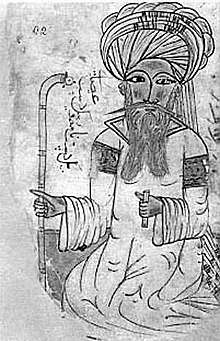
In the 11th century, Persian polymath Ibn Sina (Avicenna) agreed with Philoponus' theory that "the moved object acquires an inclination from the mover" as an explanation for projectile motion.[13] Ibn Sina then published his own theory of impetus in The Book of Healing (c. 1020). Unlike Philoponus, who believed that it was a temporary virtue that would decline even in a vacuum, Ibn Sina viewed it as a persistent, requiring external forces such as air resistance to dissipate it.[14][15][16] Ibn Sina made distinction between 'force' and 'inclination' (mayl), and argued that an object gained mayl when the object is in opposition to its natural motion. He concluded that continuation of motion is attributed to the inclination that is transferred to the object, and that object will be in motion until the mayl is spent.[17]
Another 11th-century Persian polymath, Al-Biruni, proposed that heavenly bodies have mass, weight, and gravity, just like the Earth. He criticized both Aristotle and Ibn Sina for holding the view that heavenly bodies lack these properties and that only the Earth has mass, weight and gravity.[18] The 12th-century scholar Al-Khazini suggested that the gravity an object contains varies depending on its distance from the centre of the universe (referring to the centre of the Earth). Al-Biruni and Al-Khazini studied the theory of the centre of gravity, and generalized and applied it to three-dimensional bodies. They also founded the theory of ponderable lever, and created the science of gravity. Fine experimental methods were also developed for determining the specific gravity or specific weight of objects, based the theory of balances and weighing.[19]
In the 12th century, Abu'l-Barakāt al-Baghdādī adopted and modified Avicenna's theory on projectile motion. In his Kitab al-Mu'tabar, Abu'l-Barakat stated that the mover imparts a violent inclination (mayl qasri) on the moved and that this diminishes as the moving object distances itself from the mover.[20] He also gave an explanation for the gravitational acceleration of falling bodies. He proposed an explanation of the acceleration of falling bodies by the accumulation of successive increments of power with successive increments of velocity.[21] According to Shlomo Pines, al-Baghdādī's theory of motion was "the oldest negation of Aristotle's fundamental dynamic law [namely, that a constant force produces a uniform motion], [and is thus an] anticipation in a vague fashion of the fundamental law of classical mechanics [namely, that a force applied continuously produces acceleration]."[22]
The 12th-century Arab polymath Ibn Bajjah proposed that for every force there is always a reaction force. While he did not specify that these forces be equal, it was an early version of the third law of motion which states that for every action there is an equal and opposite reaction.[23] In the 16th century, Al-Birjandi explained the Earth's rotation by developing a hypothesis similar to Galileo Galilei's notion of circular inertia,[24] which attempted to explain planetary orbits without gravity.[25]
European Renaissance
In the 14th century, both the French philosopher Jean Buridan and the Merton College of Oxford rejected the Aristotelian concept of gravity.[26][lower-alpha 2] They attributed the motion of objects to an impetus (akin to momentum), which varies according to velocity and mass;[26] Buridan was influenced in this by Ibn Sina's Book of Healing.[16] Buridan and Albert of Saxony (c. 1320–1390) adopted Abu'l-Barakat's theory that the acceleration of a falling body is a result of its increasing impetus.[20] Influenced by Buridan, Albert developed a square law regarding the relationship between the speed of an object in free fall and either the time or space elapsed. He also theorized that mountains and valleys are caused by erosion[lower-alpha 3]—displacing the Earth's centre of gravity.[27][lower-alpha 4] Also in this century, the Merton College developed the mean speed theorem, which was proved by Nicole Oresme (c. 1323–1382) and would be influential in later gravitational equations.[26]
Leonardo da Vinci (1452–1519) wrote that the "mother and origin of gravity" is energy. He describes two pairs of physical powers which stem from a metaphysical origin and have an effect on everything: abundance of force and motion, and gravity and resistance. He associates gravity with the 'cold' classical elements, water and earth, and calls its energy infinite.[29] Leonardo did not publish his manuscripts and they had no direct influence on subsequent science.[30] By 1514, Nicolaus Copernicus had written an outline of his heliocentric model, in which he recognized Earth's centre as the centre of both its revolution and the Moon's orbit.[31][lower-alpha 5] In 1533, German humanist Petrus Apianus described the exertion of gravity:[lower-alpha 6]
Since it is apparent that in the descent [along the arc] there is more impediment acquired, it is clear that gravity is diminished on this account. But because this comes about by reason of the position of heavy bodies, let it be called a positional gravity [i.e. gravitas secundum situm][34]
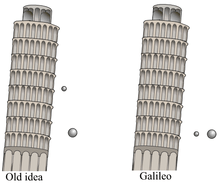
Galileo Galilei derived his kinematics from the 14th-century Merton College and Jean Buridan.[26] In the early 17th century, Galileo found that, counter to Aristotle's teachings, all objects in free fall tend to accelerate equally in relation to the duration of their fall.[36] In a 1604 letter to Paolo Sarpi, Galileo correctly hypothesized that the distance of a falling object is proportional to the square of the time elapsed.[37][lower-alpha 8]
In 1609, Johannes Kepler published Astronomia nova, in which he established his first two laws of planetary motion; the first of these determines that planetary orbits are ellipses. Galileo received a copy of this book from Kepler, as well as a letter from Federico Cesi which treats elliptical orbits as common knowledge, but never implemented them himself.[38] Galileo had been trying to determine the path of an object falling from rest towards the center of the Earth, but used a semicircular orbit in his calculation.[39] In his Dialogue Concerning the Two Chief World Systems (1632), he put forth the basic principle of relativity, which establishes that the laws of physics are the same in any system moving at a constant speed in a continuous direction.[lower-alpha 9]
A disciple of Galileo, Evangelista Torricelli reiterated Aristotle's model involving a gravitational centre, adding his view that a system can only be in equilibrium when the common centre itself is unable to fall.[33]
European Enlightenment
The relation of the distance of objects in free fall to the square of the time taken was confirmed by Francesco Maria Grimaldi and Giovanni Battista Riccioli between 1640 and 1650. They also made a calculation of the gravitational constant by recording the oscillations of a pendulum.[40]
Mechanical explanations
In 1644, René Descartes proposed that no empty space can exist and that a continuum of matter causes every motion to be curvilinear. Thus, centrifugal force thrusts relatively light matter away from the central vortices of celestial bodies, lowering density locally and thereby creating centripetal pressure.[41][42] Utilizing aspects of this theory, between 1669 and 1690, Christiaan Huygens designed a mathematical vortex model. In one of his proofs, he shows that the distance elapsed by an object dropped from a spinning wheel will increase proportionally to the square of the wheel's rotation time.[43] In 1671, Robert Hooke speculated that gravitation is the result of bodies emitting waves in the aether.[44][lower-alpha 10] Nicolas Fatio de Duillier (1690) and Georges-Louis Le Sage (1748) proposed a corpuscular model using some sort of screening or shadowing mechanism. In 1784, Le Sage posited that gravity could be a result of the collision of atoms, and in the early 19th century, he expanded Daniel Bernoulli's theory of corpuscular pressure to the universe as a whole.[45] A similar model was later created by Hendrik Lorentz (1853–1928), who used electromagnetic radiation instead of corpuscles.
English mathematician Isaac Newton utilized Descartes' argument that curvilinear motion constrains inertia,[46] and in 1675, argued that aether streams attract all bodies to one another.[lower-alpha 11] Newton (1717) and Leonhard Euler (1760) proposed a model in which the aether loses density near mass, leading to a net force acting on bodies. Mechanistic models fell out of favor because most of them lead to an unacceptable amount of drag, which was not observed. Others violate the energy conservation law and are incompatible with modern thermodynamics.[47]
Some mechanical explanations of gravitation (including Le Sage's theory) were created between 1650 and 1900 to explain Newton's theory, but they were overthrown because most of them lead to an unacceptable amount of drag, which is not observed. Other models violate the energy conservation law and are incompatible with modern thermodynamics.
.jpg)
Newton's law
As a result of Robert Hooke's suggestion that there is a gravitational force which depends on the inverse square of the distance,[48] Isaac Newton was able to mathematically derive Kepler's three kinematic laws of planetary motion, including the elliptical orbits for the six then-known planets and the Moon. In 1687, Newton published Philosophiæ Naturalis Principia Mathematica, which hypothesizes the inverse-square law of universal gravitation. In his own words:
I deduced that the forces which keep the planets in their orbs must be reciprocally as the squares of their distances from the centres about which they revolve; and thereby compared the force requisite to keep the moon in her orb with the force of gravity at the surface of the earth; and found them to answer pretty nearly.
Newton's original formula was:
where the symbol means "is proportional to". To make this into an equal-sided formula or equation, there needed to be a multiplying factor or constant that would give the correct force of gravity no matter the value of the masses or distance between them (the gravitational constant). Newton would need an accurate measure of this constant to prove his inverse-square law. This was first performed by Henry Cavendish in 1797.[lower-alpha 12]
In Newton's theory[52] (rewritten using more modern mathematics) the density of mass generates a scalar field, the gravitational potential in joules per kilogram, by
Using the Nabla operator for the gradient and divergence (partial derivatives), this can be conveniently written as:
This scalar field governs the motion of a free-falling particle by:
At distance r from an isolated mass M, the scalar field is
Failing to define a medium in which it interacted, Newton's theory seemed to require action at a distance.[53] His theory, and Joseph-Louis Lagrange's improvement on the calculation (applying the variational principle), do not take into account relativistic effects, which were unknown at that time. Even so, Newton's theory is thought to be exceptionally accurate in the limit of weak gravitational fields and low speeds.
Newton's theory enjoyed its greatest success when it was used to predict the existence of Neptune based on motions of Uranus that could not be accounted by the actions of the other planets. Calculations by John Couch Adams and Urbain Le Verrier both predicted the general position of the planet. Le Verrier sent his position to Johann Gottfried Galle, asking him to verify. The same night, Galle spotted Neptune near the position Le Verrier had predicted.[54]
By the end of the 19th century, Le Verrier showed that the orbit of Mercury could not be accounted for entirely under Newtonian gravity, and all searches for another perturbing body (such as a planet orbiting the Sun even closer than Mercury) were fruitless.[55]
Modern era
Albert Einstein developed his theory of relativity in papers published in 1905 and 1915. In 1914, Gunnar Nordström attempted to unify gravity and electromagnetism in his theory of five-dimensional gravitation.[lower-alpha 13] In 1919, general relativity superseded all other gravitational models, including Newton's laws, when gravitational lensing around a solar eclipse matching Einstein's equations was observed by Arthur Eddington. Thereafter, German mathematician Theodor Kaluza promoted the idea of general relativity with a fifth dimension, which in 1921 Swedish physicist Oskar Klein gave a physical interpretation of in a prototypical string theory, a possible model of quantum gravity and potential theory of everything.

Einstein's field equations include a cosmological constant to account for the alleged staticity of the universe. However, Edwin Hubble observed in 1929 that the universe appears to be expanding. By the 1930s, Paul Dirac developed the hypothesis that gravitation should slowly and steadily decrease over the course of the history of the universe.[56] Alan Guth and Alexei Starobinsky proposed in 1980 that cosmic inflation in the very early universe could have been driven by a negative pressure field, a concept later coined 'dark energy'—found in 2013 to have composed around 68.3% of the early universe.[57]
In 1922, Jacobus Kapteyn proposed the existence of dark matter, an unseen force that moves stars in galaxies at higher velocities than gravity alone accounts for. It was found in 2013 to have comprised 26.8% of the early universe.[57] Along with dark energy, dark matter is an outlier in Einstein's relativity, and an explanation for its apparent effects is a requirement for a successful theory of everything.
In 1957, Hermann Bondi proposed that negative gravitational mass (combined with negative inertial mass) would comply with the strong equivalence principle of general relativity and Newton's laws of motion. Bondi's proof yielded singularity-free solutions for the relativity equations.[58]
Early theories of gravity attempted to explain planetary orbits (Newton) and more complicated orbits (e.g. Lagrange). Then came unsuccessful attempts to combine gravity and either wave or corpuscular theories of gravity. The whole landscape of physics was changed with the discovery of Lorentz transformations, and this led to attempts to reconcile it with gravity. At the same time, experimental physicists started testing the foundations of gravity and relativity – Lorentz invariance, the gravitational deflection of light, the Eötvös experiment. These considerations led to and past the development of general relativity.
Electrostatic models (1870–1900)
At the end of the 19th century, many tried to combine Newton's force law with the established laws of electrodynamics, like those of Weber, Carl Friedrich Gauss, Bernhard Riemann and James Clerk Maxwell. Those models were used to explain the perihelion precession of Mercury. In 1890, Lévy succeeded in doing so by combining the laws of Weber and Riemann, whereby the speed of gravity is equal to the speed of light in his theory. And in another attempt, Paul Gerber (1898) even succeeded in deriving the correct formula for the Perihelion shift (which was identical to that formula later used by Einstein). However, because the basic laws of Weber and others were wrong (for example, Weber's law was superseded by Maxwell's theory), those hypothesis were rejected.[59] In 1900, Hendrik Lorentz tried to explain gravity on the basis of his Lorentz ether theory and the Maxwell equations. He assumed, like Ottaviano Fabrizio Mossotti and Johann Karl Friedrich Zöllner, that the attraction of opposite charged particles is stronger than the repulsion of equal charged particles. The resulting net force is exactly what is known as universal gravitation, in which the speed of gravity is that of light. But Lorentz calculated that the value for the perihelion advance of Mercury was much too low.[60]
In the late 19th century, Lord Kelvin pondered the possibility of a theory of everything.[61] He proposed that every body pulsates, which might be an explanation of gravitation and electric charges. However, his ideas were largely mechanistic and required the existence of the aether, which the Michelson–Morley experiment failed to detect in 1887. This, combined with Mach's principle, led to gravitational models which feature action at a distance.
Lorentz-invariant models (1905–1910)
Based on the principle of relativity, Henri Poincaré (1905, 1906), Hermann Minkowski (1908), and Arnold Sommerfeld (1910) tried to modify Newton's theory and to establish a Lorentz invariant gravitational law, in which the speed of gravity is that of light. As in Lorentz's model, the value for the perihelion advance of Mercury was much too low.[62]
Einstein (1905, 1908, 1912)
In 1905, Albert Einstein published a series of papers in which he established the special theory of relativity and the fact that mass and energy are equivalent. In 1907, in what he described as "the happiest thought of my life", Einstein realized that someone who is in free fall experiences no gravitational field. In other words, gravitation is exactly equivalent to acceleration.
Einstein's two-part publication in 1912[63][64] (and before in 1908) is really only important for historical reasons. By then he knew of the gravitational redshift and the deflection of light. He had realized that Lorentz transformations are not generally applicable, but retained them. The theory states that the speed of light is constant in free space but varies in the presence of matter. The theory was only expected to hold when the source of the gravitational field is stationary. It includes the principle of least action:
where is the Minkowski metric, and there is a summation from 1 to 4 over indices and .
Einstein and Grossmann[65] includes Riemannian geometry and tensor calculus.
The equations of electrodynamics exactly match those of general relativity. The equation
is not in general relativity. It expresses the stress–energy tensor as a function of the matter density.
Abraham (1912)
While this was going on, Abraham was developing an alternative model of gravity in which the speed of light depends on the gravitational field strength and so is variable almost everywhere. Abraham's 1914 review of gravitation models is said to be excellent, but his own model was poor.
Nordström (1912)
The first approach of Nordström (1912)[66] was to retain the Minkowski metric and a constant value of but to let mass depend on the gravitational field strength . Allowing this field strength to satisfy
where is rest mass energy and is the d'Alembertian,
and
where is the four-velocity and the dot is a differential with respect to time.
The second approach of Nordström (1913)[67] is remembered as the first logically consistent relativistic field theory of gravitation ever formulated. (notation from Pais[68] not Nordström):
where is a scalar field,
This theory is Lorentz invariant, satisfies the conservation laws, correctly reduces to the Newtonian limit and satisfies the weak equivalence principle.
Einstein and Fokker (1914)
This theory[69] is Einstein's first treatment of gravitation in which general covariance is strictly obeyed. Writing:
they relate Einstein–Grossmann[65] to Nordström.[67] They also state:
That is, the trace of the stress energy tensor is proportional to the curvature of space.
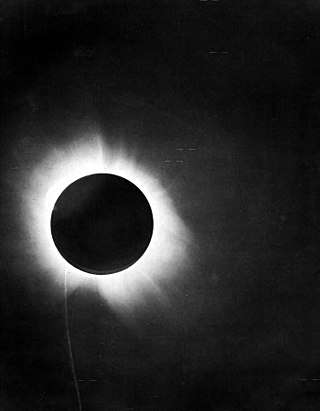
Between 1911 and 1915, Einstein developed the idea that gravitation is equivalent to acceleration, initially stated as the equivalence principle, into his general theory of relativity, which fuses the three dimensions of space and the one dimension of time into the four-dimensional fabric of spacetime. However, it does not unify gravity with quanta—individual particles of energy, which Einstein himself had postulated the existence of in 1905.
General relativity
In general relativity, the effects of gravitation are ascribed to spacetime curvature instead of to a force. The starting point for general relativity is the equivalence principle, which equates free fall with inertial motion. The issue that this creates is that free-falling objects can accelerate with respect to each other. To deal with this difficulty, Einstein proposed that spacetime is curved by matter, and that free-falling objects are moving along locally straight paths in curved spacetime. More specifically, Einstein and David Hilbert discovered the field equations of general relativity, which relate the presence of matter and the curvature of spacetime. These field equations are a set of 10 simultaneous, non-linear, differential equations. The solutions of the field equations are the components of the metric tensor of spacetime, which describes its geometry. The geodesic paths of spacetime are calculated from the metric tensor.
Notable solutions of the Einstein field equations include:
- The Schwarzschild solution, which describes spacetime surrounding a spherically symmetrical non-rotating uncharged massive object. For objects with radii smaller than the Schwarzschild radius, this solution generates a black hole with a central singularity.
- The Reissner–Nordström solution, in which the central object has an electrical charge. For charges with a geometrized length less than the geometrized length of the mass of the object, this solution produces black holes with an event horizon surrounding a Cauchy horizon.
- The Kerr solution for rotating massive objects. This solution also produces black holes with multiple horizons.
- The cosmological Robertson–Walker solution, which predicts the expansion of the universe.
General relativity has enjoyed much success because its predictions (not called for by older theories of gravity) have been regularly confirmed. For example:
- General relativity accounts for the anomalous perihelion precession of Mercury.[55]
- Gravitational lensing was first confirmed in 1919, and has more recently been strongly confirmed through the use of a quasar which passes behind the Sun as seen from the Earth.
- The expansion of the universe (predicted by the Robertson–Walker metric) was confirmed by Edwin Hubble in 1929.
- The prediction that time runs slower at lower potentials has been confirmed by the Pound–Rebka experiment, the Hafele–Keating experiment, and the GPS.
- The time delay of light passing close to a massive object was first identified by Irwin Shapiro in 1964 in interplanetary spacecraft signals.
- Gravitational radiation has been indirectly confirmed through studies of binary pulsars such as PSR 1913+16.
- In 2015, the LIGO experiments directly detected gravitational radiation from two colliding black holes, making this the first direct observation of both gravitational waves and black holes.[70]
It is believed that neutron star mergers (since detected in 2017)[71] and black hole formation may also create detectable amounts of gravitational radiation.
Quantum gravity
Several decades after the discovery of general relativity, it was realized that it cannot be the complete theory of gravity because it is incompatible with quantum mechanics.[72] Later it was understood that it is possible to describe gravity in the framework of quantum field theory like the other fundamental forces. In this framework, the attractive force of gravity arises due to exchange of virtual gravitons, in the same way as the electromagnetic force arises from exchange of virtual photons.[73][74] This reproduces general relativity in the classical limit, but only at the linearized level and postulating that the conditions for the applicability of Ehrenfest theorem holds, which is not always the case. Moreover, this approach fails at short distances of the order of the Planck length.[72]
Theoretical models such as string theory and loop quantum gravity are current candidates for a possible 'theory of everything'.
See also
References
Footnotes
- The source of this quote is Al-Biruni's India (c. 1030).[11]
- This was interpreted as deriving the weight of objects from the pressure of the air below them.[26]
- Leonardo da Vinci tested this theory by observing trace fossils,[27] which he used to argue against the myth of a universal flood.[28]
- Furthermore, he hypothesized that the planet is in equilibrium when its centre of gravity coincides with that of its mass.[27]
- He accounted for these movements by explaining, "Rotation is natural to a sphere, and by that very act is its shape expressed."[32]
- Physicist Pierre Duhem erroneously attributes this to Jordanus Nemorarius, whom he calls the "precursor of Leonardo". Leonardo alludes to Jordanus in his notebooks, but not to any of his theories.[33]
- Some historians consider this to have been a thought experiment rather than a physical test as there is little evidence that it actually took place.[35]
- The distance traversed in successive equal intervals of time is calculated with a triangular model whose width (representing maximum velocity) increases by two for every equal section of height (representing time elapsed). This is in part anticipated by the Merton rule.[37]
- This principle provided the basic framework for Newton's laws of motion and is central to Albert Einstein's special theory of relativity.
- James Challis repeated this assumption in 1869.
- Bernhard Riemann made a similar argument in 1853.
- Many sources incorrectly state that this was the first measurement of G (or the Earth's density).[49] There were previous measurements, chiefly by Bouguer (1740) and Maskelyne (1774), but they were very inaccurate.[50][51]
- In string theory, dimensions exceeding four allow for the existence of parallel realities—which along with the anthropic principle, help to explain the statistical near-impossibility of our fine-tuned universe.
Citations
- Smith, Homer W. (1952). Man and His Gods. New York: Grosset & Dunlap. p. 144.
- Edward Grant, The Foundations of Modern Science in the Middle Ages, (Cambridge: Cambridge Univ. Pr., 1996), pp. 60-1.
- Olaf Pedersen, Early Physics and Astronomy, (Cambridge: Cambridge Univ. Pr., 1993), p. 130
- Reviel Neitz; William Noel (2011-10-13). The Archimedes Codex: Revealing The Secrets Of The World's Greatest Palimpsest. Hachette UK. ISBN 9781780221984.
- CJ Tuplin, Lewis Wolpert (2002). Science and Mathematics in Ancient Greek Culture. Hachette UK. p. xi. ISBN 9780198152484.
- Vitruvius, Marcus Pollio (1914). "7". In Alfred A. Howard (ed.). De Architectura libri decem [Ten Books on Architecture]. VII. Herbert Langford Warren, Nelson Robinson (illus), Morris Hicky Morgan. Harvard University, Cambridge: Harvard University Press. p. 215.
- Pickover, Clifford (2008). Archimedes to Hawking: Laws of Science and the Great Minds Behind Them. Oxford University Press. p. 105. ISBN 978-0-19-979268-9.
- Bose, Mainak Kumar (1988). Late classical India. A. Mukherjee & Co.
- Sen, Amartya (2005). The Argumentative Indian. Allen Lane. p. 29. ISBN 978-0-7139-9687-6.
- Thurston, Hugh (1993). Early Astronomy. New York: Springer-Verlag. ISBN 978-0-387-94107-3.
- Alberuni's India. London: Kegan Paul, Trench, Trübner & Co., 1910. Electronic reproduction. Vol. 1 and 2. New York: Columbia University Libraries, 2006. p. 272. Retrieved 3 June 2014.
- Kitāb al-Jawharatayn al-'atīqatayn al-mā'i'atayn min al-ṣafrā' wa-al-bayḍā' : al-dhahab wa-al-fiḍḍah. Cairo : Maṭba'at Dār al-Kutub wa-al-Wathā'iq al-Qawmīyah bi-al-Qāhirah (Arabic: كتاب الجوهرتين العتيقتين المائعتين من الصفراء والبيضاء : الذهب والفضة) 2004. pp. 43–44, 87. OCLC 607846741.
- McGinnis, Jon; Reisman, David C. (2007). Classical Arabic philosophy: an anthology of sources. Hackett Publishing. p. 174. ISBN 978-0-87220-871-1. Retrieved 16 June 2010.
- Espinoza, Fernando (2005). "An analysis of the historical development of ideas about motion and its implications for teaching". Physics Education. 40 (2): 141. Bibcode:2005PhyEd..40..139E. doi:10.1088/0031-9120/40/2/002.
- Seyyed Hossein Nasr & Mehdi Amin Razavi (1996). The Islamic intellectual tradition in Persia. Routledge. p. 72. ISBN 978-0-7007-0314-2.
- Aydin Sayili (1987). "Ibn Sīnā and Buridan on the Motion of the Projectile". Annals of the New York Academy of Sciences. 500 (1): 477–482. Bibcode:1987NYASA.500..477S. doi:10.1111/j.1749-6632.1987.tb37219.x.
- Espinoza, Fernando. "An Analysis of the Historical Development of Ideas About Motion and its Implications for Teaching". Physics Education. Vol. 40(2).
- Starr, S. Frederick (2015). Lost Enlightenment: Central Asia's Golden Age from the Arab Conquest to Tamerlane. Princeton University Press. p. 260. ISBN 9780691165851.
- Rozhanskaya, Mariam; Levinova, I. S. (1996). "Statics". In Rushdī, Rāshid (ed.). Encyclopedia of the History of Arabic Science. 2. Psychology Press. pp. 614–642. ISBN 9780415124119.
Using a whole body of mathematical methods (not only those inherited from the antique theory of ratios and infinitesimal techniques, but also the methods of the contemporary algebra and fine calculation techniques), Muslim scientists raised statics to a new, higher level. The classical results of Archimedes in the theory of the centre of gravity were generalized and applied to three-dimensional bodies, the theory of ponderable lever was founded and the 'science of gravity' was created and later further developed in medieval Europe. The phenomena of statics were studied by using the dynamic approach so that two trends – statics and dynamics – turned out to be inter-related within a single science, mechanics. The combination of the dynamic approach with Archimedean hydrostatics gave birth to a direction in science which may be called medieval hydrodynamics. ... Numerous fine experimental methods were developed for determining the specific weight, which were based, in particular, on the theory of balances and weighing. The classical works of al-Biruni and al-Khazini can by right be considered as the beginning of the application of experimental methods in medieval science.
- Gutman, Oliver (2003). Pseudo-Avicenna, Liber Celi Et Mundi: A Critical Edition. Brill Publishers. p. 193. ISBN 90-04-13228-7.
- Crombie, Alistair Cameron, Augustine to Galileo 2, p. 67.
- Pines, Shlomo (1970). "Abu'l-Barakāt al-Baghdādī , Hibat Allah". Dictionary of Scientific Biography. 1. New York: Charles Scribner's Sons. pp. 26–28. ISBN 0-684-10114-9.
(cf. Abel B. Franco (October 2003). "Avempace, Projectile Motion, and Impetus Theory", Journal of the History of Ideas 64 (4), p. 521-546 [528].) - Franco, Abel B.. "Avempace, Projectile Motion, and Impetus Theory". Journal of the History of Ideas. Vol. 64(4): 543.
- Ragep, F. Jamil (2001b). "Freeing Astronomy from Philosophy: An Aspect of Islamic Influence on Science". Osiris. 2nd Series. 16 (Science in Theistic Contexts: Cognitive Dimensions): 49–64, 66–71 (63–4, 152–3). doi:10.1086/649338.
- Dijksterhuis, E.J. The Mechanization of the World Picture, IV, 121, Oxford University Press, 1961.
- Gillispie 1960, p. 41.
- Knight, Kevin (2017). "Albert of Saxony". New Advent. Retrieved 10 July 2019.
- Da Vinci, Leonardo (1971). Taylor, Pamela (ed.). The Notebooks of Leonardo da Vinci. New American Library. pp. 136–38, 142–48.
- Da Vinci, Leonardo (1971). Taylor, Pamela (ed.). The Notebooks of Leonardo da Vinci. New American Library. p. 124.
Force arises from dearth or abundance; it is the child of physical motion, and the grandchild of spiritual motion, and the mother and origin of gravity. Gravity is limited to the elements of water and earth; but his force is unlimited, and by it infinite worlds might be moved if instruments could be made by which the force be generated.
Force, with physical motion, and gravity, with resistance, are the four external powers on which all actions of mortals depend. - Capra, Fritjof (2007). The Science of Leonardo. US: Doubleday. pp. 5–6. ISBN 978-0-385-51390-6.
- Durant, Will (2011) [1957]. The Story of Civilization: Volume VI – The Reformation. Simon and Schuster. p. 823. ISBN 9781451647631.
- Gillispie 1960, p. 27.
- Ginzburg, Benjamin (September 1936). "Duhem and Jordanus Nemorarius". Isis. The University of Chicago Press. 25 (2): 341–362. doi:10.1086/347085. JSTOR 225373.
- Duhem, Pierre (2012). The Origins of Statics: The Sources of Physical Theory Volume 1. Translated by Leneaux, G. F.; Vagliente, V. N.; Wagener, G. H. Springer Science & Business Media. p. xxiv. ISBN 9789401137300.
- "El experimento más famoso de Galileo probablemente nunca tuvo lugar". The Conversation (in Spanish). 16 May 2019. Retrieved 24 August 2019.
- Gillispie 1960, p. 42.
- Gillispie 1960, pp. 3–6.
- Caspar, Max (1993) [1962]. Kepler. Translated by Hellman, Clarisse Doris. North Chelmsford, MA: Courier Corporation. p. 137. ISBN 978-0-486-67605-0.
- Gillispie 1960, p. 51.
- J.L. Heilbron, Electricity in the 17th and 18th Centuries: A Study of Early Modern Physics (Berkeley: University of California Press, 1979), 180.
- Gillispie 1960, p. 93.
- Descartes, René (1644). Principles of Philosophy.
- Gillispie 1960, p. 121.
- Taylor, William Bower (1876). . Smithsonian Report: 205–282.
- Gillispie 1960, p. 480.
- Gillispie 1960, p. 120.
- Zenneck, J. (1903). "Gravitation". Encyklopädie der Mathematischen Wissenschaften mit Einschluss Ihrer Anwendungen. Leipzig. 5 (1): 25–67. doi:10.1007/978-3-663-16016-8_2. ISBN 978-3-663-15445-7.
- Cohen, I. Bernard; George Edwin Smith (2002). The Cambridge Companion to Newton. Cambridge University Press. pp. 11–12. ISBN 978-0-521-65696-2.
- Feynman, Richard P. (1963). "7. The Theory of Gravitation". mainly mechanics, radiation and heat. The Feynman lectures on physics. Volume I. Pasadena, California: California Institute of Technology (published 2013). 7–6 Cavendish's experiment. ISBN 9780465025626. Retrieved May 22, 2019.
- Poynting 1894
- Encyclopædia Britannica 1910
- Newton, I. (1686). Philosophiæ Naturalis Principia Mathematica (in Latin).
- Gillispie 1960, p. 144.
- Chisholm, Hugh, ed. (1911). . Encyclopædia Britannica. 1 (11th ed.). Cambridge University Press. pp. 177–178.
- Einstein, Albert (1916). "The Foundation of the General Theory of Relativity" (PDF). Annalen der Physik. 49 (7): 769–822. Bibcode:1916AnP...354..769E. doi:10.1002/andp.19163540702. Retrieved 2006-09-03.
- Haber, Heinz (1967) [1965]. "Die Expansion der Erde" [The expansion of the Earth]. Unser blauer Planet [Our blue planet]. Rororo Sachbuch [Rororo nonfiction] (in German) (Rororo Taschenbuch Ausgabe [Rororo pocket edition] ed.). Reinbek: Rowohlt Verlag. p. 52. Bibcode:1967ubp..book.....H.
Der englische Physiker und Nobelpreisträger Dirac hat ... vor über dreißig Jahren die Vermutung begründet, dass sich das universelle Maß der Schwerkraft im Laufe der Geschichte des Universums außerordentlich langsam, aber stetig verringert." English: "The English physicist and Nobel laureate Dirac has ..., more than thirty years ago, substantiated the assumption that the universal strength of gravity decreases very slowly, but steadily over the course of the history of the universe.
- "Big Bang's afterglow shows universe is 80 million years older than scientists first thought". The Washington Post. Archived from the original on 22 March 2013. Retrieved 22 March 2013.
- Bondi, H. (1957). "Negative mass in general relativity". Reviews of Modern Physics. 29 (3): 423–428. Bibcode:1957RvMP...29..423B. doi:10.1103/revmodphys.29.423.
- Zenneck, J. (1903). Gravitation. Encyklopädie der Mathematischen Wissenschaften mit Einschluss Ihrer Anwendungen (in German). 5. pp. 25–67. doi:10.1007/978-3-663-16016-8_2. ISBN 978-3-663-15445-7.
- Lorentz, H.A. (1900). "Considerations on Gravitation" (PDF). Proceedings of the Royal Netherlands Academy of Arts and Sciences (KNAW). 2: 559–574.
- Thompson, Silvanus P. (2019). "Lord Kelvin". International Electrotechnical Commission. Retrieved October 16, 2019.
- Walter, S. (2007). Renn, J. (ed.). "Breaking in the 4-vectors: the four-dimensional movement in gravitation, 1905–1910" (PDF). The Genesis of General Relativity. Berlin. 3: 193–252. Bibcode:2007ggr..conf..193W.
- Einstein, A (1912). "Lichtgeschwindigkeit und Statik des Gravitationsfeldes". Annalen der Physik (in German). 38 (7): 355–369. Bibcode:1912AnP...343..355E. doi:10.1002/andp.19123430704.
- Einstein, A (1912). "Zur Theorie des statischen Gravitationsfeldes". Annalen der Physik (in German). 38 (7): 443. Bibcode:1912AnP...343..443E. doi:10.1002/andp.19123430709.
- Einstein, A. and Grossmann, M. (1913), Zeitschrift für Mathematik und Physik 62, 225
- Nordström, G (1912). "Relativitätsprinzip und Gravitation". Physikalische Zeitschrift (in German). 13: 1126.
- Nordström, G (1913). "Zur Theorie der Gravitation vom Standpunkt des Relativitätsprinzips". Annalen der Physik. 42 (13): 533. Bibcode:1913AnP...347..533N. doi:10.1002/andp.19133471303.
- Pais, Abraham (2005). Subtle is the Lord: The Science and Life of Albert Einstein. New York: Oxford University Press. ISBN 978-0-19-152402-8. OCLC 646798828.
- Einstein, A.; Fokker, A. D. (1914). "Die Nordströmsche Gravitationstheorie vom Standpunkt des absoluten Differentkalküls" (PDF). Annalen der Physik. 44 (10): 321–328. Bibcode:1914AnP...349..321E. doi:10.1002/andp.19143491009.
- Abbott, Benjamin P.; et al. (LIGO Scientific Collaboration and Virgo Collaboration) (2016). "Observation of Gravitational Waves from a Binary Black Hole Merger". Phys. Rev. Lett. 116 (6): 061102. arXiv:1602.03837. Bibcode:2016PhRvL.116f1102A. doi:10.1103/PhysRevLett.116.061102. PMID 26918975. Lay summary (PDF).
- Abbott, B. P.; Abbott, R.; Abbott, T. D.; Acernese, F.; Ackley, K.; Adams, C.; Adams, T.; Addesso, P.; Adhikari, R. X.; Adya, V. B.; Affeldt, C.; Afrough, M.; Agarwal, B.; Agathos, M.; Agatsuma, K.; Aggarwal, N.; Aguiar, O. D.; Aiello, L.; Ain, A.; Ajith, P.; Allen, B.; Allen, G.; Allocca, A.; Altin, P. A.; Amato, A.; Ananyeva, A.; Anderson, S. B.; Anderson, W. G.; Angelova, S. V.; et al. (2017). "Multi-messenger Observations of a Binary Neutron Star Merger". The Astrophysical Journal Letters. 848 (2): L12. arXiv:1710.05833. Bibcode:2017ApJ...848L..12A. doi:10.3847/2041-8213/aa91c9.
- Randall, Lisa (2005). Warped Passages: Unraveling the Universe's Hidden Dimensions. Ecco. ISBN.
- Feynman, R. P.; Morinigo, F. B.; Wagner, W. G.; Hatfield, B. (1995). Feynman lectures on gravitation. Addison-Wesley. ISBN 978-0-201-62734-3.
- Zee, A. (2003). Quantum Field Theory in a Nutshell. Princeton University Press. ISBN.
Sources
- Gillispie, Charles Coulston (1960). The Edge of Objectivity: An Essay in the History of Scientific Ideas. Princeton University Press. ISBN 0-691-02350-6.CS1 maint: ref=harv (link)
